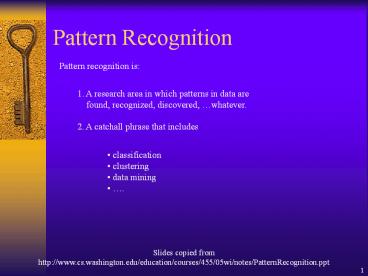Pattern Recognition - PowerPoint PPT Presentation
Title:
Pattern Recognition
Description:
Pattern Recognition Pattern recognition is: 1. A research area in which patterns in data are found, recognized, discovered, whatever. 2. A catchall phrase that ... – PowerPoint PPT presentation
Number of Views:98
Avg rating:3.0/5.0
Title: Pattern Recognition
1
Pattern Recognition
Pattern recognition is
1. A research area in which patterns in data are
found, recognized, discovered, whatever. 2.
A catchall phrase that includes
- classification
- clustering
- data mining
- .
Slides copied fromhttp//www.cs.washington.edu/ed
ucation/courses/455/05wi/notes/PatternRecognition.
ppt
2
Two Schools of Thought
- Statistical Pattern Recognition
- The data is reduced to vectors of numbers
- and statistical techniques are used for
- the tasks to be performed.
- 2. Structural Pattern Recognition
- The data is converted to a discrete
structure - (such as a grammar or a graph) and the
- techniques are related to computer
science - subjects (such as parsing and graph
matching).
3
In this course
1. How should objects to be classified be
represented? 2. What algorithms can be used for
recognition (or matching)? 3. How should
learning (training) be done?
4
Classification in Statistical PR
- A class is a set of objects having some
important - properties in common
- A feature extractor is a program that inputs the
- data (image) and extracts features that can be
- used in classification.
- A classifier is a program that inputs the
feature - vector and assigns it to one of a set of
designated - classes or to the reject class.
With what kinds of classes do you work?
5
Feature Vector Representation
- Xx1, x2, , xn, each xj a real number
- xj may be an object measurement
- xj may be count of object parts
- Example object rep. holes, strokes, moments,
6
Possible features for char rec.
7
Some Terminology
- Classes set of m known categories of objects
- (a) might have a known description for
each - (b) might have a set of samples for each
- Reject Class
- a generic class for objects not in any
of - the designated known classes
- Classifier
- Assigns object to a class based on
features
8
Discriminant functions
- Functions f(x, K) perform some computation on
feature vector x - Knowledge K from training or programming is used
- Final stage determines class
9
Classification using nearest class mean
- Compute the Euclidean distance between feature
vector X and the mean of each class. - Choose closest class, if close enough (reject
otherwise)
10
Nearest mean might yield poor results with
complex structure
- Class 2 has two modes where is
- its mean?
- But if modes are detected, two subclass mean
vectors can be used
11
Nearest Neighbor Classification
- Keep all the training samples in some efficient
- look-up structure.
- Find the nearest neighbor of the feature vector
- to be classified and assign the class of the
neighbor. - Can be extended to K nearest neighbors.
12
Bayesian decision-making
- Classify into class w that is most likely based
on - observations X. The following distributions
are - needed.
- Then we have
13
Classifiers often used in CV
- Decision Tree Classifiers
- Artificial Neural Net Classifiers
- Bayesian Classifiers and Bayesian Networks
- (Graphical Models)
- Support Vector Machines
14
Receiver Operating Curve ROC
- Plots correct detection rate versus false alarm
rate - Generally, false alarms go up with attempts to
detect higher percentages of known objects
15
A recent ROC from our work
16
Confusion matrix shows empirical performance
Confusion may be unavoidable between some
classes, for example, between 9s and 4s.































